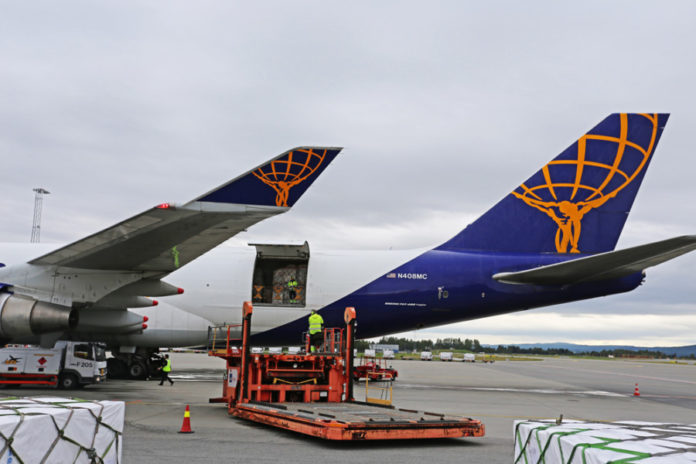

Everything from medicines and salmon to sophisticated aircraft parts for US fighter jets move in and out of Scandinavia by air.
While there is much land and sea traffic with the biggest trading partners such as the Netherlands, Germany, Poland and France, the huge markets in the US and the growing demands of Asia, especially China, require the swift transport that only airfreight can provide.
The giant of air cargo handling in Scandinavia is Spirit Air Cargo Handling, which is owned by Scandinavian Airlines and has been in business for more than 55 years under different names. The brand, Spirit Air Cargo Handling, was first implemented in Sweden 2004 and two years later in Norway and Denmark.
Spirit Air Cargo Handling operates in Stockholm, Gothenburg, Malmo, Oslo, Copenhagen, Billund and Aalborg with services that includes bonded warehousing, ramp handling, documentation and customs clearance, and ULD control and management.
Kjetil Håbjørg, Vice President Ground Handling said: “We always focus on new trends and demands from our customers. Safety and security are the key elements in our cargo handling and quality in our handling is another important element.”
He added: “Even though we see an even higher demand for quality, we also find that price is still the major factor for airlines and forwarding agents.
“For new developments, we are looking into a way of expanding and diversifying our use of technology.”
Spirit has received Centre of Excellence of Independent Validators (CEIV) pharma certificates for Copenhagen, Oslo and Stockholm Arlanda. To get these, the company has made major investments in storage capacity. New procedures have been implemented and all staff have received training in how to handle time and temperature-sensitive shipments.
One of the signs of growth in the region is that, alongside the main players in the industry, such as Spirit and DHL, smaller, independent logistics companies have started up over the past 20 years and are thriving, such as Scandinavian Shipping & Logistics, which began in 1999, Greencarrier Freight Services, which was launched in 2000 and NTEX, which was founded in 2003 in Gothenburg.
A spokesman for Scandinavian Shipping & Logistics said that customer requirements have changed a great deal in the recent past.
“Earlier, they could accept two departures per week while daily departures are required today. The supplier list – airlines – has increased quite a lot giving the freight forwarders more options to find solutions for their customers.
Today the pricing is under more pressure than before and it goes hand in hand with the increased number of services available in the market,” the spokesman said.
The regional giant Sweden, with double the populations of its two neighbours, is highly dependent on exports, which make up about 50 per cent of the country’s GDP, compared with a global average of just over 25 per cent. Sweden’s global trade is very diverse, whereas elsewhere seafood and pharma dominate.
Three Swedish airports can accommodate heavy cargo aircraft: Stockholm Arlanda, Gothenburg Landvetter and Malmo.
While the capital’s airport is supreme, with the headquarters of most of the country’s export companies and shipping agents, Gothenburg Landvetter is close to the biggest harbour in Scandinavia and Malmo is near Copenhagen in Denmark and provides some benefits in cost and flexibility as a small airport.
The north is best served by Lulea Airport on the northern end of the Gulf of Bothnia. It is growing as a means of exporting salmon from northern Norway.
Despite being dwarfed by its northern neighbour, Denmark has the biggest hub in northern Europe in Copenhagen airport, which has the benefit of not being subject to curfews.
Copenhagen’s new cargo centre is expected to be completed by the end of next year. The $50 million development by German company AXXUS will cover 20,000m² and is being built on empty land in the existing cargo area.
The new facility, which will have direct access to airside, will include the latest technology and will have refrigeration for food and pharma products.
The growth in belly cargo is one of the spurs for the Copenhagen project.
“Especially on the long-haul intercontinental air routes, belly cargo is a particularly important part of the business,” said Peter Krogsgaard, the Copenhagen Airport Chief Commercial Officer.
“This cargo can make up more than 10 per cent of revenue on a route. Today, belly cargo accounts for 40 per cent of the total tonnage at CPH and is up seven per cent this year. We’re actively working to attract even more long-haul routes, so it’s an important part of our strategy to create a good platform for air cargo at CPH.”
In Norway, Oslo is dominant, especially for international airfreight, and consequently the number of all-cargo aircraft operating at the airport has grown. The second biggest handler of exports and imports is Stavanger, although with a fraction of the volumes at Oslo.
Bergen airport deals with domestic cargo almost exclusively, although such is the dominance of Oslo that this amounts to less than half the amount that going through the capital’s airport.
The huge amount of air cargo being handled at Oslo is continuing to grow, with 185,000 tonnes last year translating to an increase of 35 per cent over 2016, as reported in Air Cargo Week in February.
Much of this growth is in seafood, with Espen Andersen, of Leroys Seafood, saying that more direct flights from Oslo “is providing us with better access to our most important markets”.
Revenues in Norway are now steadily growing after a volatile decade. In 2008 Norwegian airfreight generated $92.5 million. This grew to a peak of more than $100 million in 2011 before plummeting to just over $67.5 million the following year.
While not yet back up to the highs of the early mid to late Noughties, revenues are on the up again after a drop between 2014 and 2015 and are predicted to approach $85 million in 2020.













